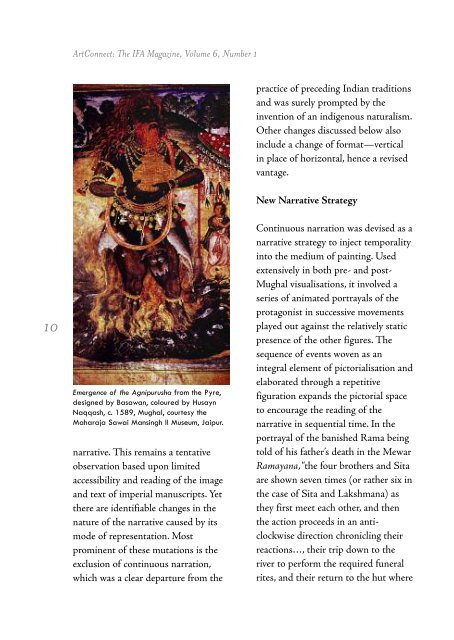Layout 3 - India Foundation for the Arts - IFA
Layout 3 - India Foundation for the Arts - IFA
Layout 3 - India Foundation for the Arts - IFA
Create successful ePaper yourself
Turn your PDF publications into a flip-book with our unique Google optimized e-Paper software.
10<br />
ArtConnect: The <strong>IFA</strong> Magazine, Volume 6, Number 1<br />
Emergence of <strong>the</strong> Agnipurusha from <strong>the</strong> Pyre,<br />
designed by Basawan, coloured by Husayn<br />
Naqqash, c. 1589, Mughal, courtesy <strong>the</strong><br />
Maharaja Sawai Mansingh II Museum, Jaipur.<br />
narrative. This remains a tentative<br />
observation based upon limited<br />
accessibility and reading of <strong>the</strong> image<br />
and text of imperial manuscripts. Yet<br />
<strong>the</strong>re are identifiable changes in <strong>the</strong><br />
nature of <strong>the</strong> narrative caused by its<br />
mode of representation. Most<br />
prominent of <strong>the</strong>se mutations is <strong>the</strong><br />
exclusion of continuous narration,<br />
which was a clear departure from <strong>the</strong><br />
practice of preceding <strong>India</strong>n traditions<br />
and was surely prompted by <strong>the</strong><br />
invention of an indigenous naturalism.<br />
O<strong>the</strong>r changes discussed below also<br />
include a change of <strong>for</strong>mat—vertical<br />
in place of horizontal, hence a revised<br />
vantage.<br />
New Narrative Strategy<br />
Continuous narration was devised as a<br />
narrative strategy to inject temporality<br />
into <strong>the</strong> medium of painting. Used<br />
extensively in both pre- and post-<br />
Mughal visualisations, it involved a<br />
series of animated portrayals of <strong>the</strong><br />
protagonist in successive movements<br />
played out against <strong>the</strong> relatively static<br />
presence of <strong>the</strong> o<strong>the</strong>r figures. The<br />
sequence of events woven as an<br />
integral element of pictorialisation and<br />
elaborated through a repetitive<br />
figuration expands <strong>the</strong> pictorial space<br />
to encourage <strong>the</strong> reading of <strong>the</strong><br />
narrative in sequential time. In <strong>the</strong><br />
portrayal of <strong>the</strong> banished Rama being<br />
told of his fa<strong>the</strong>r’s death in <strong>the</strong> Mewar<br />
Ramayana, “<strong>the</strong> four bro<strong>the</strong>rs and Sita<br />
are shown seven times (or ra<strong>the</strong>r six in<br />
<strong>the</strong> case of Sita and Lakshmana) as<br />
<strong>the</strong>y first meet each o<strong>the</strong>r, and <strong>the</strong>n<br />
<strong>the</strong> action proceeds in an anticlockwise<br />
direction chronicling <strong>the</strong>ir<br />
reactions…, <strong>the</strong>ir trip down to <strong>the</strong><br />
river to per<strong>for</strong>m <strong>the</strong> required funeral<br />
rites, and <strong>the</strong>ir return to <strong>the</strong> hut where


